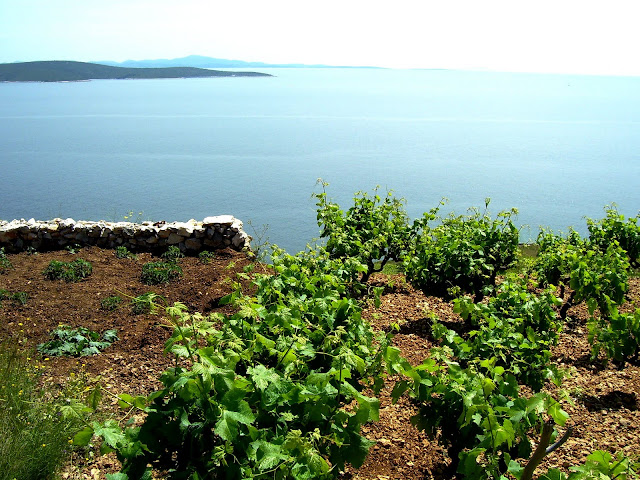Croatia Wines Speak Volumes From Bottle
At first blush, Crljenak Kastelanski, Grasevina, Plavac Mali, Pošip - some of Croatia’s grape varietals - sounded Greek to me. Since OPA is the only Greek word I know, pronouncing these grape names sent my mind into a tailspin.
In fact, I was so overwhelmed by the names of Croatian wines, winemakers, and labels that I couldn’t imagine writing about them without mastering the spelling first. Then I scanned several sources and talked to a Croatia wine expert. That said, I cheered up and decided to give these wines a swirl.
Istrian Teran red wine by Franc Arman
The Greeks influenced wine cultivation and culture in Croatia well before the Romans arrived in 9 AD. Situated on the Adriatic Sea, Croatia is bordered by Hungary, Serbia, Bosnia, Herzegovina, and Montenegro. The history of this nation of nearly 4.5 million includes wars, invasions, and being part of the Ottoman Empire.
As a result, Croatia shares a history, culture, language, and customs with some of its bordering neighbors. Yet despite calamities, natural or man-made, viticulture traditions have survived. So much so that Croatia now has a burgeoning, modern wine industry.
In 2002, a team from University of California at Davis concluded that DNA testing had revealed that the origin of California’s Zinfandel and Italy’s Primitivo grapes was Croatia’s indigenous grape, Crljenak Kastelanski.
The discovery put Croatia on the map, so to speak; it also made worldwide headlines. The revelation, however, did not come as a surprise to winemaker Miljenko “Mike” Grgich, an immigrant from Croatia. He had suspected the Croatia connection based on his family’s wine grapes growing up.
“Grgich was the one who launched the search for Zinfandel. Nobody knew where Zinfandel came from until UC Davis put together a research team that went to Italy to investigate Primitivo,” said Cliff Rames, a New York-based sommelier and founder of the Wines of Croatia web site.
“When the researchers didn't find enough evidence to tie Zinfandel to Italy (in fact there was Primitivo, which is Zinfandel, but there was no other DNA cross-over with other local grapes, suggesting that Primitivo was a transplant and not originating in the area). That's when they checked out Croatia and found tons of DNA cross-over with local grapes and then finally located the source: Crljenak Kastelanski, the original Zin.”
In 1976, Grgich had represented a prestigious California winery in the Napa Valley at a Paris wine tasting. The event launched his fame as a winemaker when he beat out the French in the “David versus Goliath” competition.
In 1991, Croatia declared its independence from Yugoslavia. That’s when the country really began moving forward after years of communist rule. Family-owned wineries were also resurrected after years of communist repression. Today, Croatia is an emerging economy poised to become part of the European Union in 2013.
In the mid-1990s, armed with Croatian pride, Grgich left California for a Croatian sabbatical aimed at teaching Croatians high-tech winemaking skills. That was the beginning of a decades-long effort to promote and market hidden gems of the wine industry.
“Croatia has centuries of winemaking traditions. Many of the wineries are still family owned. But in the last 20 years, there’s been a revolution. There’s been an emergence of new wineries,” said Rames, whose father is Croatian.
One of the factors that make Croatia’s wines unique is the diverse terroir. Another factor is that the wines are less commercial than those from other countries. Croatian families take pride in producing wines from hand-picked grapes.
Jim Croce’s famous song, “Time in a Bottle” comes to mind as Rames talks passionately about the wines that inspired him to become a sommelier in the 30-plus years he has been shuttling there from New York.
"These wines are not just about the notes, the flavors, and the color. These wines are about the terroir, the history, and the people for whom this is a lifestyle not a business. One comment I hear a lot is ‘this doesn’t taste like anything I’ve ever tried before’ and so perhaps this is a niche market,” he said.
Breaking down tongue-twisting terms and studying the Croatia landscape was a great help in trying to understand Croatia’s terroir and wine production. First off, on a map Croatia looks as if it is two separate countries.
Part of the country is lodged underneath Austria and Hungary. This may be the reason for its diverse soils and why some grape varietals thrive while others perish. Once I wrapped my head around the geographic area, I was closer to understanding the saga of these wines.
The two main wine-growing regions are Continental and Coastal. The inland Continental region runs north and south along the Drava and Sava rivers, which flow east into the famous Danube. Situated beneath Hungary and Slovenia, the Continental region’s climate is rainy and warm.
By comparison, the Coastal region runs north and south along the Adriatic Sea coast. The coastal area has more than 1,000 tiny islands nearby sparsely populated by generations of sea-loving, wine-loving Croatians.

The Continental region has seven wine-growing sub-regions while the Coastal has five wine-growing sub-regions. Moreover, Croatia has more than 300 distinct wine-producing regions. Once you realize this, you soon grasp that this country is a wine lover’s paradise.
Slavonia, known as Croatia’s “breadbasket” because of its farmland, is one of the best known sub-regions within the Continental region. Zagorje-Medimurje, also in this area, is one of the oldest wine-producing regions. Both sub-regions boast inspiring bucolic vineyards.
The Continental region is white wine country known primarily for producing fresh, crisp white wines. The wines are derived from the Grasevina white grape, also known as the Welschriesling. The wines are food-friendly and range from dry to sweet.
The Coastal region is home to the popular Istria sub-region on the northern coast. The Malvasia Istriana grape thrives here. In fact, it is the second most widely planted grape in Croatia. The red Teran, an indigenous grape, also flourishes in this sub-region. Other grapes that grow well here are: Cabernet Sauvigon, Merlot, and Gamay.
Damaltia, the southernmost wine-producing region, is red wine country. It’s also another sub-region in the Coastal region. The grape varieties that grow well are those that can tolerate the heat. Plavac Mali, a red grape, yields some of the region’s best reds. Plavac Mali is believed to also be an offspring of Crljenak Kastelanski.
Beyond the challenging grape names, the wine labels and winemakers can also seem mind boggling. Try grasping Krauthaker Grasevina, Bura Plavac Mali, Enjingi, and BIBICh Debit Lucica. Even so, the most daunting challenge now is nationwide distribution in the US.
“The greatest challenge is that outside of New York, Chicago, Los Angeles and San Francisco, there is no distribution of these wines. Right now in the United States, there are only about 25 labels and three importers, Vinum USA, Blue Danube Wine Company, and Tasty Wine Company,” said Rames.
In Houston, a spokesman for SPEC’S, a third-generation wine, spirit,s and gourmet foods store, said they get Croatian wines occasionally from a specialty distributor. But it’s only a handful of bottles, since there’s no demand. The precious few are only available in SPEC’s flagship store in downtown Houston.
Even if Americans start asking for the wines, another challenge is that compared to those from traditional wine producing countries, these wines are not cheap. A bottle of Croatian wine can cost more than $10, while wines from Spain, Australia, and France start at $10 at select stores.
“Croatia can’t compete with large wine-producing countries like Spain, France, and Australia. Less than one percent of its agricultural land is devoted to vines. We’re talking thousands of bottles not millions. We’re talking about wineries that produce 100,000 bottles or less a year,” he said.
Nevertheless, if wine aficionados want to uncork time in a bottle, which reflects hand-harvested grapes, unique terroir, and centuries of history, Rames recommends they give the wines of Croatia a try.
“There are still those who would buy a wine based on a point system. But if you want something unique and special, I’d recommend Croatia wines. Personally, I like to drink wines made from grapes native to the area. And I find that people appreciate authenticity,” he said.
For information on Croatia wine delivery, go to
vinumusa.com
bluedanubewine.com
winesofcroatia.com
specsonline.com
Rosie Carbo is the Lifestyles Editor for Wandering Educators
Feature photo: Plavac Mali Vineyards, Hvar island, Dalmatia, Coastal Croatia
All photos courtesy and copyright Cliff Rames, Wines of Croatia
-

- Log in to post comments



















